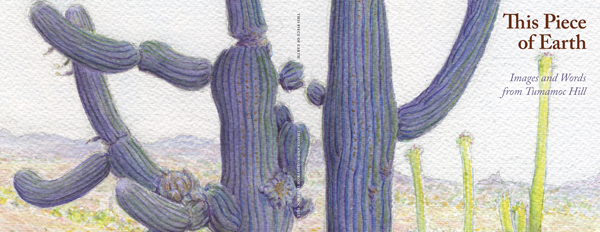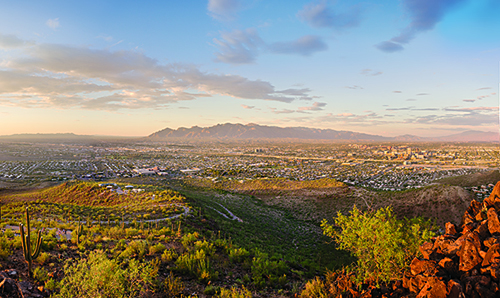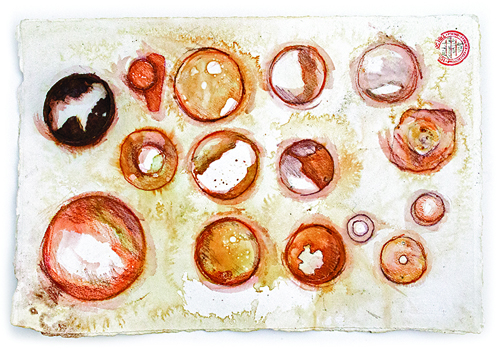Tumamoc’s Artistic Inspiration

“This Piece of Earth: Images and Words from Tumamoc Hill” book cover.
Tumamoc Hill. It broods on our western vista from Downtown Tucson, visible to the south and north for miles. Looming like an acropolis over the west central edge of Tucson proper, and marking the eastern outliers of the Tucson Mountains, its 3,108 foot peak and massive width dwarfs, by contrast, Sentinel Peak, aka “A” Mountain, topping out at 2,897 feet.
How the 860 acre parcel with the Hill at its center–surrounded by Anklam, Greasewood and Mission Roads–came to be as protected as it was, how it has been so close to the old and new center of Tucson, and yet has remained relatively untouched by time, is a story of the cross-currents of science and public institutions both past and present. Portions of the preserve contain some of the most studied plant plots in biology and botanical science. But not everything is known or can be experienced through science. A previously missing piece of the Tumamoc Hill story, which is really part of Tucson’s story, is intuitive, visual, historical. The artistic story of this piece of Tucson had been lacking in a way that places like San Xavier del Bac, Old Tucson, or the Rodeo Grounds have not.
Now, thanks to Tumamoc: People and Habitats, a project of the College of Science, University of Arizona, we have a volume of poetry, paintings, photography and drawings entitled, “This Piece of Earth – Images and Words from Tumamoc Hill” to bring the beauty and history of this certain quintessential piece of greater Tucson to us.
Writers from Tucson’s poetry group POG and local artists converged on the preserve, interacting with science researchers and historians, learning about the “Hill’s” long history and Sonoran desert vegetation and animals. In all, thirteen contributors provided ample evidence of the profound impact of a close personal relationship between artist and place. As visual artist and photographer Paul Mirocha puts it in his artist’s statement, “limiting the scope of my artwork to one small bounded place, such as Tumamoc, has profoundly changed how I think and work.”

“Looking North from Slope of Tumamoc Hill Towards the Desert Lab and Road with Walkers,” by Paul Mirocha.
Page after page of this beautifully designed art book draws the viewer and reader into and out of both visual and literary interaction with the massif. Stunning black and white photography, found object collages, watercolors, and sketches intermingle powerfully with simple and sublime poetry.
One of the more fascinating approaches to artistic interaction with the preserve is the work of Kathleen Koopman. Allowed, as those who regularly walk the Hill are not, to stray off the main asphalt track to the top of the Hill from Anklam Road, Ms. Koopman gathered weathered historical objects, identified as far as they could be and placed them in collage form. These weathered human objects leave a palpable reminder of what was there and is gone, as she states in the book, “I was soon drawn to the physical artifacts strewn across the land… looking at, listening, and arranging these objects offers insight into the layers and depths of the history of this place.”
Pleine-air painter Meredith Milstead found painting at the preserve, visually interacting with barrel cacti, ocotillo, and the giant saguaro, to be life-changing, and writes, “When I look at a barrel blooming in the morning sunlight, it glows and radiates light and I want to convey that. The more I draw on Tumamoc, the more it comes, all of nature radiating, all integrated, myself included. Watching the changing light and color on Tumamoc helps me to become a better artist and a deeper person, more tender and generous.”
In “Wind on the Hill,” poet Valerina Quintana takes the reader to the solitude that the walker can find hiking on the Tumamoc road on a windy day:
Here, on this piece of earth known as the Sonoran Desert,
Here, on an even smaller patch called Tumamoc Hill,
it takes time to quiet myself to see the wind.
The wind that is everywhere says to me
Come away with me today. I will guide you
to the shadow places of saguaros, organ pipe and petroglyphs.
Ms. Quintana, by email, elucidates that “I have always been attracted to the wind no matter the form. What appeals to me most about the wind is its strength and its subtlety. Hearing it weave around creosote, palo verde or even the hefty saguaro; feeling it cool me on a warm sunny afternoon walk to the top of the Hill; Tumamoc reinforced a sense of place and appreciation of the occupants; native, traders, explorers, researchers, walkers.”
Poet and cultural geographer Eric Magrane, currently poet-in-residence at the Arizona-Sonora Desert Museum, writes via email, “Tumamoc is a place that cuts through categories. All the people walking the hill, the research plots, the ecology, the history, the view across the Tucson basin… everything about the place embodies the idea that nature and culture aren’t separate. Poetry and art likewise have a way of cutting through categories. I am hopeful that the more we can bring the awareness and insights of science and art together, the better our future can be. And grounding the interactions in place, like at Tumamoc, is crucial.”
On Friday, June 6, the book launch and poetry reading event takes place at Antigone Bookstore, 411 N. 4th Ave. at 7 p.m. All proceeds from book sales, $20 per copy, go to the Tumamoc Fund at the University of Arizona Foundation. For more about Tumamoc Hill and the collaborative ongoing work, artistic, historic and scientific, see Tumamoc.org and TumamocSketchbook.com. A note to walkers – please only walk the hill after 5:30 p.m., and stay on the trail to help maintain the integrity of the preserve.

Rust Monoprint #2 by Kathleen Koopman
Category: Arts, Books, Community, DOWNTOWN / UNIVERSITY / 4TH AVE




